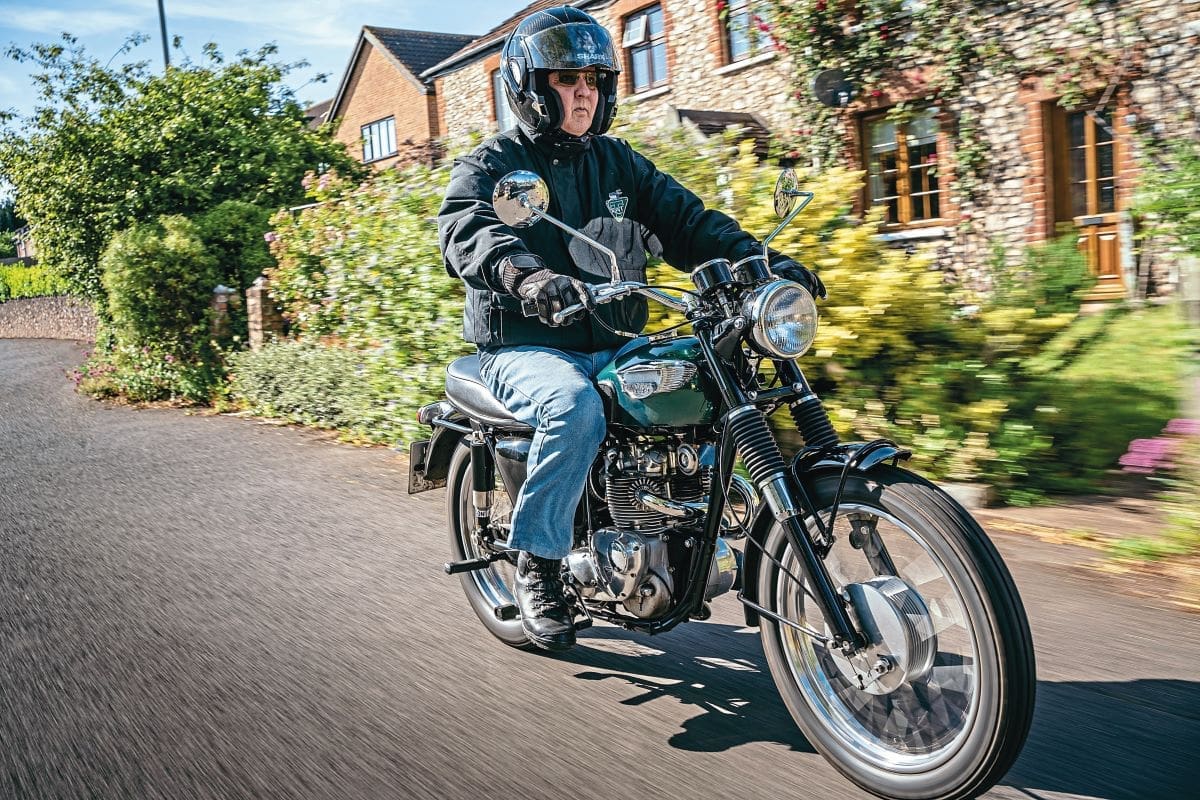Triumph’s success in American off-road competition gave birth to a dedicated racer with lights – the T100SC
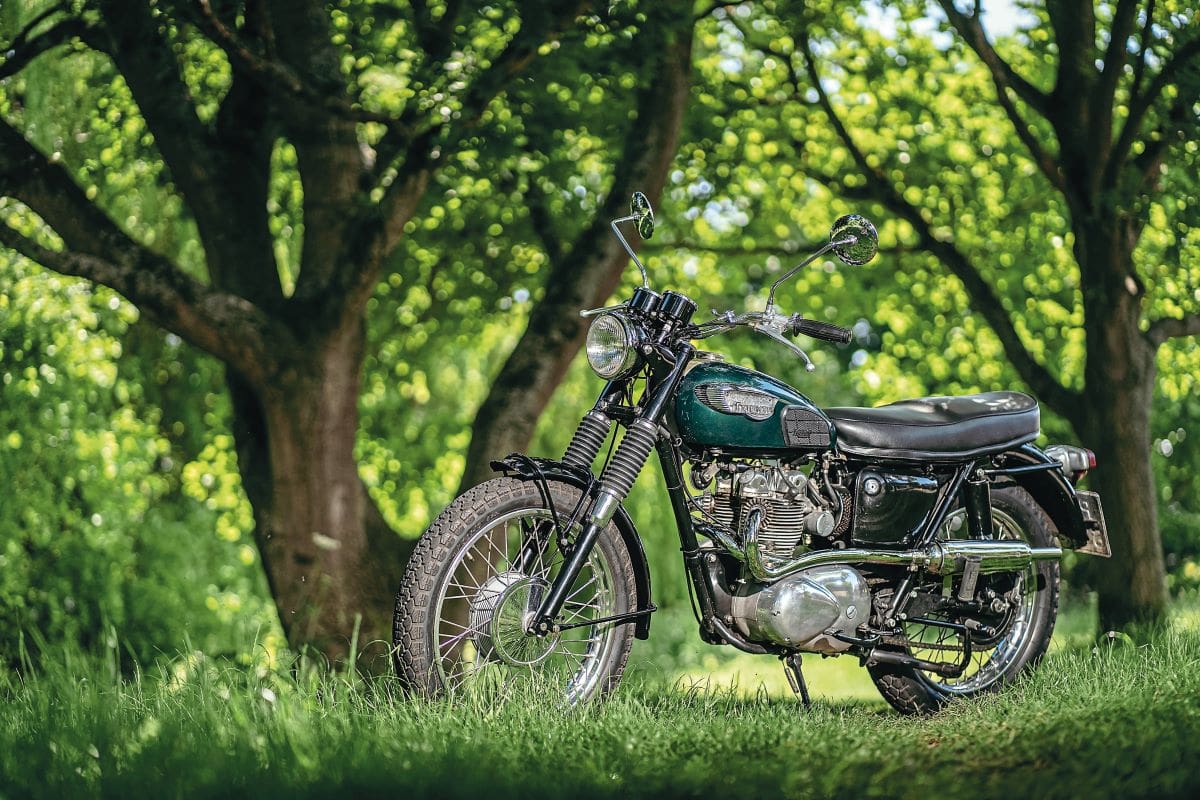
Words by Oli Hulme Photos by James Archibald
Wandering through the cider apple orchard which is home for the summer of my favourite bike night is always a pleasurable experience. There will be a Tribsa or two, probably a flat tanker andpossibly a few thumpy old 1950s British singles, which are the best thing to ride if you want to make it through the gravel car park and up into the trees without effort. A few Yamaha RD400s and, for a few brave souls willing to risk their fairings, the odd 916 Ducati or NC30 might have tackled the off-road experience rather than join the other sports bikes and classics below. With so much to see, it takes something special to make you really stop and stare.
One summer evening, as the sun set over the levels, there was a motorcycle that managed to be both discrete and very special indeed. There are always a healthy number of Triumph twins at the cider farm, but this one touched something deep inside. It wasn’t flash, but it was poised. It was a beautifully presented 500cc Triumph twin with high level pipes, and there was something about it that set the senses off. I think it’s the petrol tank, which is smaller and more slender than that used on most Triumph 500s. A quick squint at the engine number showed that this was a special and sought-after T100SC Tiger.
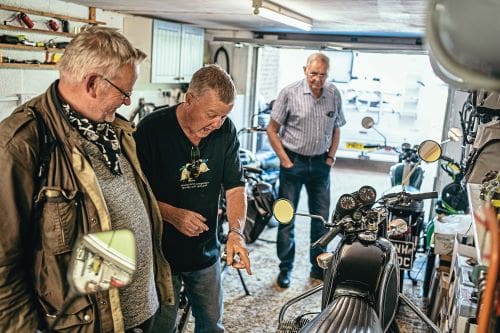
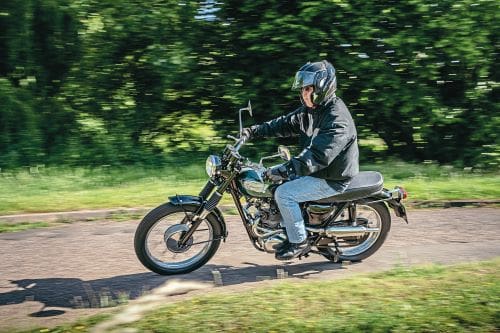
The SC stands for Street/Competition. The twin was a US market model, designed to be ready to race. All you had to do was rock up to the entrance gate of an event on your Triumph, pull off the lights and silencer, and take it to the dirt. The SC came with a wide ratio gearbox and was nicknamed the Jack Pine model, after the Jack Pine 500-mile enduro in Michigan that it competed in on many occasions in the 1960s. A home for Harley-Davidson victories through the 1930s and 1940s, Triumph arrived in the early 1950s and dominated the enduro until the late 1960s, when purpose-built Husqvarna enduro bikes became the steed of choice.
Developing the Tiger T100SC
The SC weighs just 335lb (151kg), 40lb less than a Honda C72 250 of the period, and it’s a tiny and sparse motorcycle by comparison. Indeed, it looks much more agile than any Japanese street scrambler of the 1960s or 1970s.
When Triumph built the SC, it wasn’t simply a case of slapping on a high-level exhaust and some knobbly tyres onto an existing Tiger 100. The bike was built to win trophies, and it was built properly. The handlebars are shorter than the traditional Western-style bars used on US models and were raked back about three inches. It was slightly taller than stock, the front wheel was 19in, and the whole bike has ample ground clearance. On the original SC there is there is no centrestand, though the lugs are still in place, and a lengthened sidestand compensates for the added ground clearance. The front tyre is large for the period (3.25 x 19), while the rear sports 4.00 x 18 rubber. The result is nearly nine inches of space beneath the centre of the machine and the ground, giving plenty of leeway for big rocks and deep ruts – the kind of terrain for which the Tiger SC is intended.
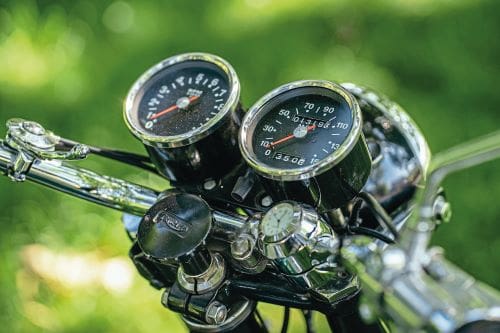
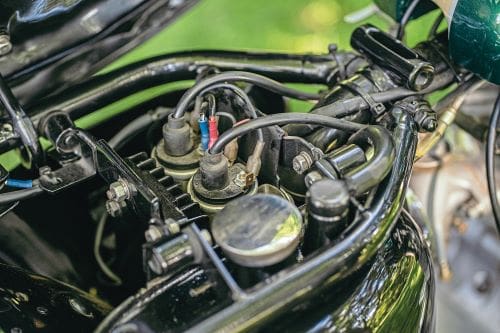
Despite the extra height, the excellent riding position afforded by the Tiger allowed shorter riders to reach the ground with both feet. This, when combined with the lightness of the Tiger, means you can imagine a smaller rider chucking it about on the dirt or easily nipping through traffic while still maintaining good balance, even at speed.
The exhaust pipes were swept around the engine to the left side. This followed US fashion, where a high pipe swept to the left, while most British examples of hi-level pipes swept round on the right. The short and curvy downpipes were smoothly joined into a single pipe that sat neatly alongside the engine. By tucking them on the left, Triumph felt there was no need for a heat shield, which is debateable. The theory seemed to be that were the pipe located on the right, its location would be complicated by the presence of the kickstart, and a hot exhaust on the right is also more likely to scorch the rider’s leg as they swing it over a bike propped up on its left-hand sidestand.
There are folding rider footpegs too, designed to be used without rubbers, which was very radical. On the original SC, the kickstart was slightly longer and straighter than stock, allowing for a bigger swing, but trying to find one of these today is akin to hunting for the Holy Grail. If you find one, you’ll discover that they are only for those with the deepest of pockets.
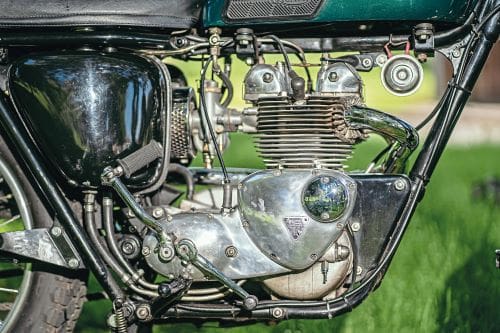

The trimmed-off petrol tank added to the machine’s cobby look, leaving the coils and other electrical gubbins exposed, which on the one hand seems odd for a motorcycle designed to cross flooded rivers, but it did mean that if anything went wrong, the rider could get at things without having to take the tank off. This would have been a time-consuming four-bolt job you didn’t want to do during an enduro.
So, you could scramble up and down the hills of Michigan. But what else was the T100SC good for? Everything. Triumph’s 500cc twin in its single carb form with a skilled rider on board was a poky little beast that would see off most machines under almost any circumstances. With high compression pistons and serious tuning as standard, the Jack Pine Special would clock 100mph, especially in the hands of the enthusiastic rider who had little mechanical sympathy. Certainly, it could be a bit buzzy and, of course, the 500 requires a lot of revs to develop its power, but the 38bhp engine is more than capable. Don’t forget that its later twin carb relative, the Daytona 500, was the fastest mass-market 500 you could buy in the UK until the arrival of Suzuki’s GS550. On the T100SC, the torque was there for the steepest inclines and the suspension would smooth out the terrain.
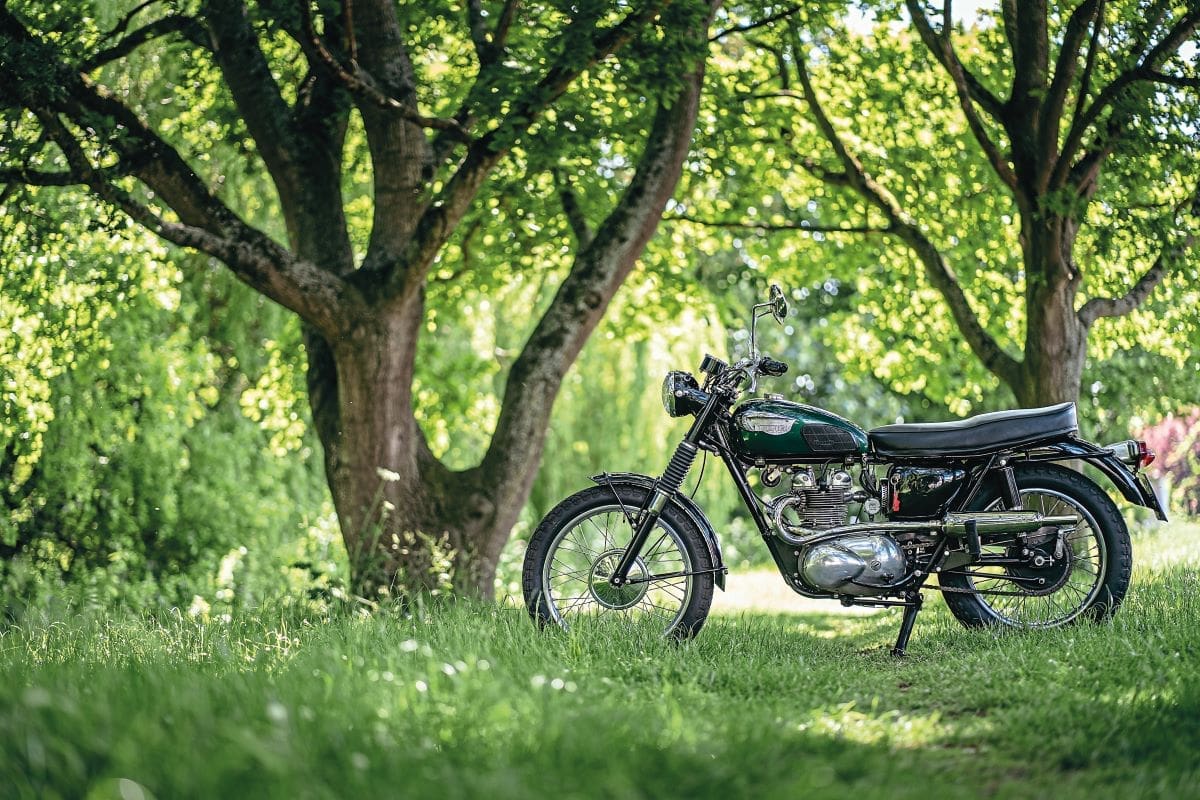
The road gearing was a compromise for off-the-road use, the rear sprocket having 46 teeth. Triumph fitted a quickly detachable headlight with a plug connector to speed up the job of prepping the T100 for an off-road adventure, especially for those who didn’t want to risk their headlight in the undergrowth.
A highly-tuned 500cc engine with 9:1 compression was quite a lot to get rolling and the Tiger required a healthy kick, especially as it came with a battery-less magneto ignition. A similar UK version with a stock tank was fitted, with a more practical battery and coil arrangement. Unless the Triumph was expertly tuned, and sometimes even if it were, it could be a challenge to start, especially from cold. The single Amal carb was equipped with a tickler to assist in starting, and that was it.
There was no ignition switch, and the rider stopped the engine by pressing the kill button located on the bars. Given the bike’s challenging starting arrangement, stopping the engine if you intend to head off again soon after might be counter- productive. Better to keep it ticking over.
The first Tiger SC bikes were immaculately painted in gold and white with a black trim, or green with a gold stripe. Chrome and polished alloy parts were selected in the factory to be strictly of the best quality. Brakes were basic Triumph with a full-width alloy hub on the front and a half width brake at the back. Both have a seven-inch diameter braking surface. With so little mass to bring to a halt, the brakes were more than adequate.
Since the 865cc Hinckley T100 Bonneville launched, some builders have tried to replicate the T100SC with the modern engine. While many of them look the part, adding 130lb (60kg) to the SC’s original weight means the modern version is very much show, not go, and spotting one joining in the Jack Pine Enduro against more purpose-built machines is certainly unlikely.
Andy’s T100SC
Andy Powell’s T100SC was built by Graham Dyer from the remains of an import that arrived from Ohio in 2014.
Graham says: “I heard from a friend that the bike had been left in storage in Bristol after being imported. It had been there for years. It seems that the owner didn’t have the money to pay the import duty and as it sat in storage, the costs kept going up. I was told I could have the bike if I paid the import duty and storage fees, so that is exactly what I did.
“It wasn’t in a good state, with no covers on it, and had suffered a bit. It came with another tank, probably from an AJS or a Matchless, but there was the right SC tank with the petrol cap offset on the right. The engine wasn’t too bad.

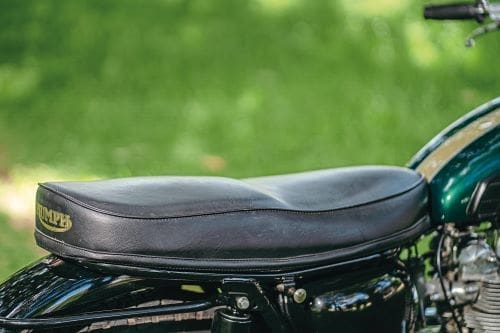
“I took it all to pieces. I had the valve gear done, had hardened valve seats fitted, and on the bottom end I put in new big end shells and bronze timing side bush, because that’s usually what causes the engine to fail in the first place. My sons rode it about for a bit, and we had it all spraypainted in the right shade of green and the black bits powder-coated.”
On the original T100SC, the coils are fixed under the petrol tank at the front in a rather messy arrangement of wires and coils, so Graham relocated them under the seat, along with other electrical components, and they are hidden under the non-standard side panels.
There’s a Boyer electronic unit that converts the electrical system from AC to DC. He has also fitted an ignition switch; Graham fitted a Sparkrite electronic ignition system, and LED lights have been installed to reduce the drain on the electrical system.
Andy says: “If you put normal wattage bulbs in, you’d turn the lights on and it would stop – or you’d find yourself trying to kick it and it wouldn’t start because the light switch was on. If you turned the lights on, it would stop running, but LED lights put much less drain on the system.”

Iridium spark plugs were used. Graham says that electronic ignition doesn’t usually need iridium plugs but the lack of a battery on the Tiger makes using them a good idea. “If you do use them,” he adds, “you need to make sure they are not mated with resistor-equipped plug caps. They’re a thinner electrode so you get a fatter spark.” Despite everything firing up, the Tiger can still be a challenge: “Sometimes the bike will go and sometimes he won’t. You just have to get the knack of it.”
Graham took a large dent out of the twisty exhaust downpipes, which was no easy task, and then had them rechromed. “The whole restoration job took about six months, I expect.”
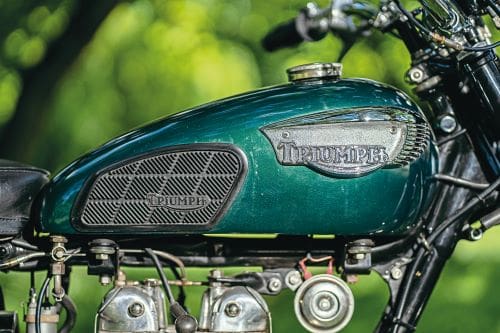

Andy got it in February 2021 when Graham decided he wanted to move it in and asked Andy to sell it for him. Andy found he could not part with it. “I think he did it on purpose,” he says. “He knew I’d end up with it.”
A centrestand has been fitted, which makes giving the kickstart a decent swing much easier, and once it is rolling the little Triumph is just what you want – a sparkly, sweet-handling little gem with a remarkable turn of speed.
The Jack Pine Enduro
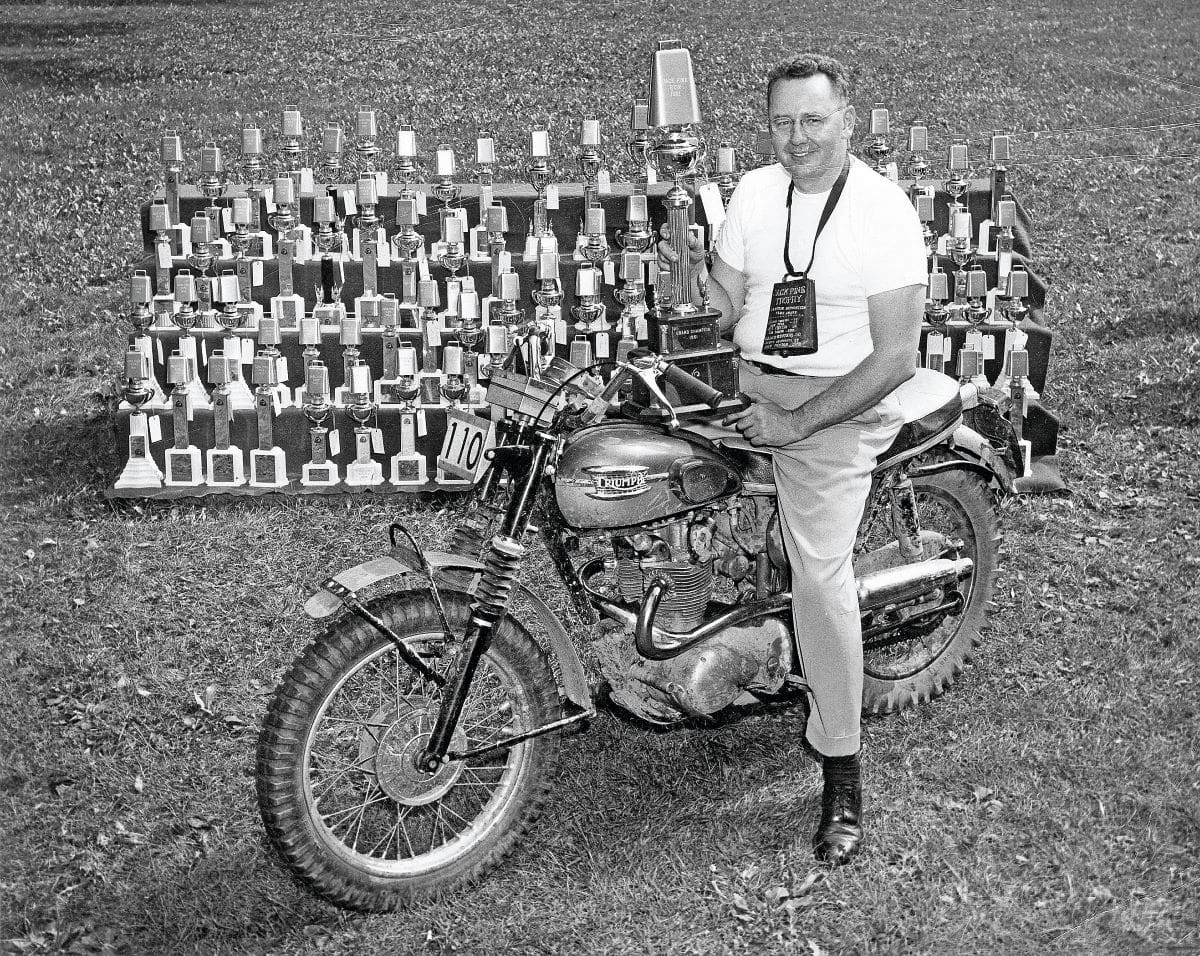
The Jack Pine Enduro started as the Jack Pine Run, by the Lansing Motorcycle Club of Michigan in 1923 – an 800-mile, three-day trek.
For many years, the run was the realm of big Harley-Davidson and Henderson motorcycles, often as combinations, fording raging rivers and climbing tortuous inclines.
In the late 1930s the club began to use as its base Jack Pine Lodge, a holiday resort and campsite in Upper Michigan. The resort had been won by the owner in a card game.
In the postwar period, British machines arrived for the competition and there were wins for AJS and BSA, with the first win by a Triumph in 1951.
Triumph competed with BSA and NSU for the top honours for next 15 years, with Triumph winning seven times, before Husqvarna started a long run of victories.
In its heyday, the Jack Pine Enduro, as it was renamed in 1959, would attract 600 or more riders tackling a course that was a gruelling 500 miles off-road over two days. The event had the same kudos in US motorcycling circles as Daytona.
These days, the enduro is shorter and runs over a single day. More purpose-built enduro bikes take part, with Gas Gas and KTM slogging it out for the top spots.
SPECIFICATION
ENGINE: 490cc OHV vertical twin BORE/STROKE: 69mm x 65.5mm COMPRESSION: 9.1:1 GEARS: Four FRONT WHEEL: 3.25 x 19 REAR WHEEL: 4.00 x 18 FRONT SUSPENSION: Telescopic hydraulic forks REAR SUSPENSION: Swinging arm, twin shocks, hydraulically damped FRONT BRAKES: Seven-inch single leading shoe REAR BRAKES: Seven-inch single leading shoe LENGTH: 84in (2133mm) SEAT HEIGHT: 30in (762mm) WHEELBASE: 55in (1397mm) DRY WEIGHT: 335lb FUEL TANK: 2.7 gallons (13.1l) POWER: 38bhp @ 7000rpm
SPECIALISTS:
Monty’s Classic Motorcycles
montysbritishclassicmotorcycles.com
Tri Cor/Andy Gregory
www.tricor-andy.com
OWNERS’ CLUB
Triumph Owners’ Club
